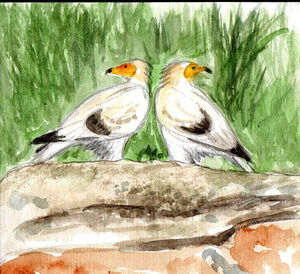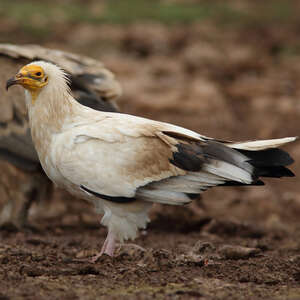Egyptian Vulture
Neophron percnopterus - Percnoptère d'Égypte Vautour percnoptère
Identification
Formerly called the European Black Vulture, the Egyptian Vulture is a small vulture whose dominant colors are black and white as an adult. Males and females are similar. The body is white, more or less tinged with reddish. White and also tinged with reddish the tail is sickle-shaped. The appearance of the wings differs above and below. The underside is very contrasted, white in front with the black remiges behind. The upper part is more complex, less bicolor. At the front, the coverts are white, tinged with reddish brown. The primary coverts are black. As for the Remiges, each has a large pale area that contributes to the paleness of the top. The head has a bare yellow face where the eyes and ears appear well. The long cRooked beak is blackish with a yellow wax pierced with nostrils. The legs are pink.
The juvenile is very different in appearance. Its plumage is brown-chocolate. The front of its head is very pale, whitish and its legs are pale pink. The plumage will gradually lighten with age until sexual maturity at 4-6 years.
Subspecific information 3 subspecies
- Neophron percnopterus percnopterus (s Europe, Middle East, Africa)
- Neophron percnopterus ginginianus (Nepal to s India)
- Neophron percnopterus majorensis (Canary Is.)
Foreign names
- Percnoptère d'Égypte,
- Alimoche común,
- britango,
- Schmutzgeier,
- dögkeselyű,
- Aasgier,
- Capovaccaio,
- smutsgam,
- Åtselgribb,
- zdochlinár biely,
- sup mrchožravý,
- Ådselgrib,
- pikkukorppikotka,
- Egiptiese Aasvoël,
- aufrany comú,
- Skarngammur,
- ścierwnik,
- baltais grifs, Ēģiptes grifs,
- egiptovski jastreb,
- Стервятник,
- エジプトハゲワシ,
- 白兀鹫,
- smutsgam,
- 白兀鷲,
Voice song and call
Habitat
The Egyptian Vulture can be found in open, dry or arid habitats of the Old World, mainly at low altitudes but locally up to 3,000 m. Steppes, semi-deserts, savannas, grasslands, croplands, edges of wetlands, coastlines, loose and forsaken urban areas and their periphery are explored in search of food.
For nesting, like other vultures, it mainly looks for steep rocky habitats that can host the nest, mainly the rock ledges of cliffs.
Behaviour character trait
The Egyptian Vulture is a territorial and monogamous species, unlike true vultures which are colonial.
Couples nest more than 1.5 km apart in densely populated territories. But outside of the breeding period, the birds are more than willing to be gregarious and can form groups of tens of individuals at feeding sites or in dormitories and resting places. Depending on the case, the Egyptian Vulture is either sedentary or migratory. Birds from the north of its range, Europeans in particular, leave the continent as soon as the youngs are emancipated, passing through the straits, Gibraltar and Suez. However, it is not impossible to see a single one in the south of Spain during the bad season. Those from south of the Sahara are either sedentary or erratic.Flight
The Egyptian Vulture has a different flight than that of true vultures. They are all gliders and can travel long distances without flapping their wings once they reach the altitude of lift. The Egyptian Vulture has narrower and more rigid wings, slightly drooping at the ends, in proportion. Its wing beats are rapid and strong, resembling a large falcon in shape.
Dietfeeding habits
The Egyptian Vulture is, like all vultures, a necrophagous detritivore. Its range of prey is wide, ranging from small dead animals, rodents, fish for example, to large domestic or wild mammals.
Its level flight of surveillance and its performing view allow it to locate its potential food. At the carcasses, it usually passes after the large vultures like the Bearded Vulture which dominate it by size, feeding on the remains. It can also descend on animals crushed on roads. It becomes commensal of Man by regularly visiting dumps where the carcasses of domestic animals are deposited.It is not exclusively a scavenger like the large vultures. It can complement its diet opportunistically by capturing invertebrates or small vertebrates, breaking large bird eggs such as ostriches. It has been seen using a stone held in the beak to do so. It can also feed on excrement.
Reproduction nesting
The breeding season is very variable depending on the regions inhabited. In Europe, it is spring but later than that of large vultures.
In the tropics, it can start as early as autumn.The species is normally monogamous and territorial, but there are exceptions. Couples are permanent.
Most of the time, the nesting is rock-made, like the large vultures of the Gyps genus. The nest, made of branches, sheep's wool and other waste materials, is installed on a ledge protected by a rock overhang, or in a hollow of the wall. It measures more than a meter in width.
The normal laying is 2 white eggs spotted with brown, red or purple and laid at 3-5 days intervals. The incubation period is a little over 40 days. The chicks are covered with a white reddish down. They will be fed the same food as the adults. They will fly at the age of 70-90 days, still remaining a month under the dependence of the parents. The reproductive success is very variable depending on the conditions of the environment. Often only the eldest will succeed in taking flight. Its life expectancy is about 40 years.
Geographic range
The Egyptian Vulture has a wide distribution across Europe, Asia and Africa north of the equator, except in the east of the continent where it extends down as far as northern Tanzania. In Europe, it can be found as far north as Ukraine. In France, it only rarely appears in the south. In terms of longitude, it ranges from the Atlantic Islands (Canaries, Cape Verde) to the east of Kazakhstan and India, which it occupies fully. It avoids the heart of the Sahara, which is far too arid.
Threats - protection
IUCN conservation status
concern
in the Wild
threatened
evaluated
The Egyptian Vulture is classified as Endangered, mainly due to its precarious situation in Europe. It has declined considerably for various easily understandable reasons in the context of increasing human control over natural environments.
The intensive use of agricultural pesticides such as rodenticides, collisions and electrocutions from electric lines, contamination through the ingestion of poisoned dead animals after pest control, and direct human persecution which persists, are all threats to this species leading to its scarcity.
Nesting sites may also be sought for human leisure activities such as mountaineering, paragliding, free flying, etc., leading to increasing disturbance.
Sources of information
- IOC World Bird List (v15.1), Gill, F and D Donsker (Eds). 2025-12-07.
Other sources of interest
 Specification sheet created on
24/07/2023 by Jean François
Specification sheet created on
24/07/2023 by Jean FrançoisTranslation by AI Oiseaux.net
© 1996-2025 Oiseaux.net
- Accipitriformes
- Aegotheliformes
- Anseriformes
- Apodiformes
- Apterygiformes
- Bucerotiformes
- Caprimulgiformes
- Cariamiformes
- Casuariiformes
- Charadriiformes
- Ciconiiformes
- Coliiformes
- Columbiformes
- Coraciiformes
- Cuculiformes
- Eurypygiformes
- Falconiformes
- Galliformes
- Gaviiformes
- Gruiformes
- Leptosomiformes
- Mesitornithiformes
- Musophagiformes
- Nyctibiiformes
- Opisthocomiformes
- Otidiformes
- Passeriformes
- Pelecaniformes
- Phaethontiformes
- Phoenicopteriformes
- Piciformes
- Podargiformes
- Podicipediformes
- Procellariiformes
- Psittaciformes
- Pterocliformes
- Rheiformes
- Sphenisciformes
- Steatornithiformes
- Strigiformes
- Struthioniformes
- Suliformes
- Tinamiformes
- Trogoniformes


































